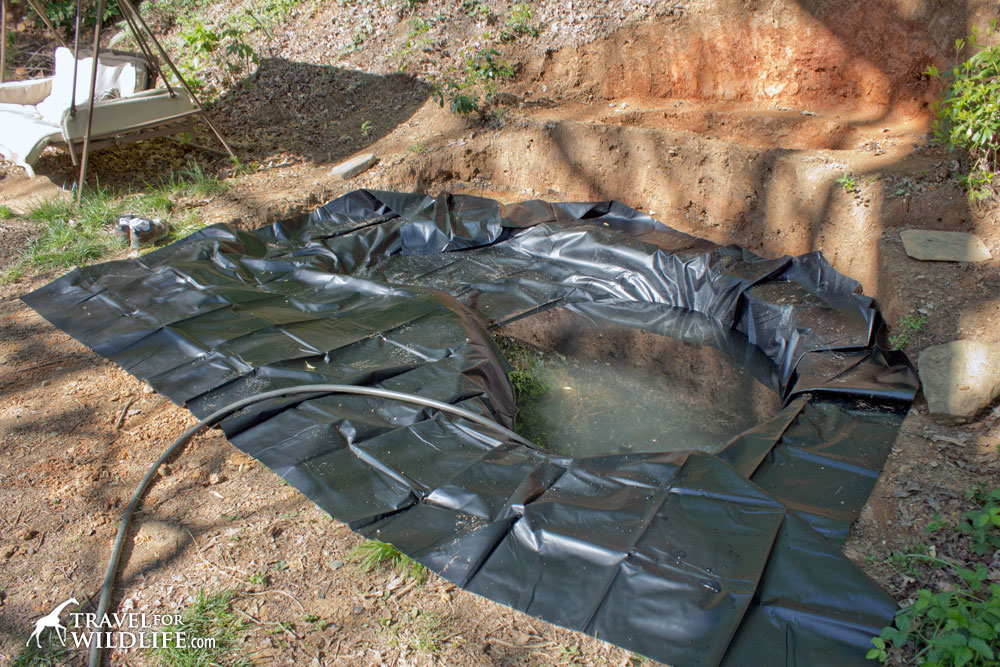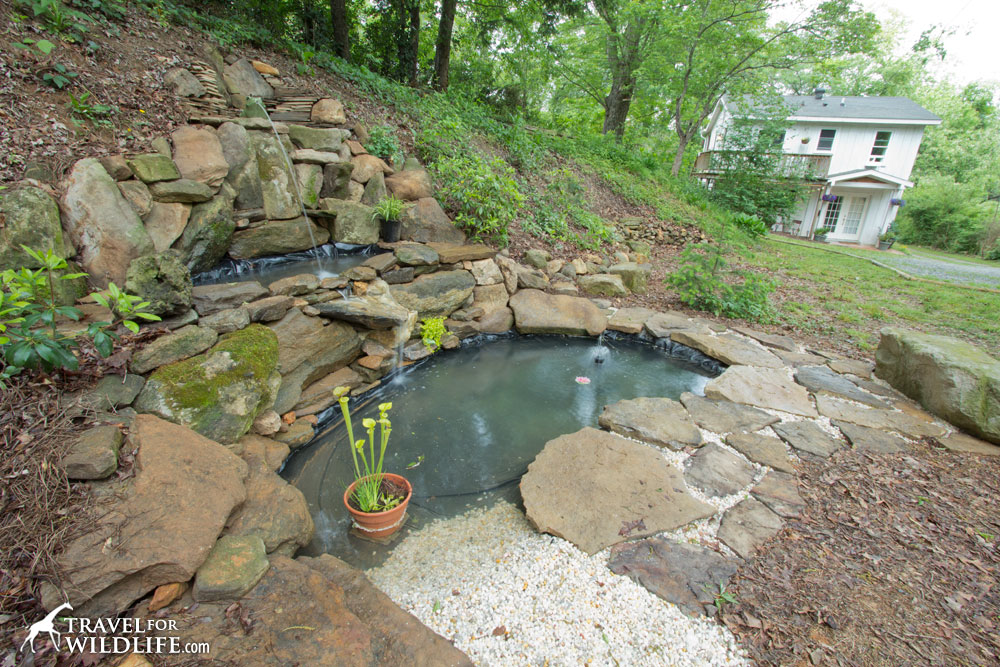Building a pond can be as easy or as elaborate as you want it to be. Either way, this water feature will attract wildlife to your yard. From birds to foxes to frogs, they’ll all be visiting your yard in no time.
It is time to re-wild our yards and to help our wild neighbors.
The Story of Our Pond
We built our first pond exactly a year ago, at the beginning of spring. Early spring is the perfect time to build your pond, as many types of wildlife are just starting to become active again. Frogs will be looking for water to breed in, and you don’t want to miss that!
Our pond took several days to finish as it has two different levels and a waterfall. A simpler pond with just one level will take less time to finish.
Our first big surprise was that only a few weeks after finishing the pond we began to notice a few water snails crawling across the pebbles on the bottom. How did they get in there? Then the frogs decided to move in. Squirrels and birds used it as a waterhole and bathtub. Little did we know that even salamanders had moved in and owls were enjoying the pond at night. We got a great surprise one day when a family of screech owls appeared on our camera trap video footage. They were drinking from our pond the previous night!
In the middle of the summer we realized that frogs loved our pond so much that they had decided to breed in it. One day hundreds of little frog eggs appeared attached to the water lilies. Soon they became tiny tadpoles. They were very shy and would tend to hide when we came around, but eventually the bigger ones would come up to our fingers and suction us with their little mouths. Then, just like that, they were gone. They turned into young tree frogs and dispersed.
What do You Need to Build a Pond for Wildlife
Here is what we used to build our pond:
- Smartpond 10×13 PVC Pond Liner
- Smartpond Pump Filter Kit
- Ceramic Frog Spitter
- Decorative River Pebbles / Accent Stones
- Sand
- Water plants like lilies and water lettuce. They will provide shelter for frog eggs and tad poles.
- A ceramic pot with carnivorous plants (or other bog plants) for dragonflies to rest on. Frogs also like to rest on the peat.
If your winters are cold, consider installing a Smartpond Pond Aerator which will prevent the pond from freezing. We have a small pond with a pump and an aerator which never froze this winter, while our slightly larger pond (which has only a pump and waterfall) froze completely solid. The difference is that the water in the pump line will freeze in very cold temperatures and block the pump, while the air in the aerator tube can never freeze!
How to Build A Pond For Wildlife
1 – First, find the location for your new pond and use a rope or string to map the shape of it. It can be any shape you want, but a simple oval or a kidney bean shape both work well.
2 – Start digging! Keep in mind that the pump filter kit needs to be under water, so the deep end needs to be deep enough to house it. Our pond’s deep end is 2.5 to 3 feet deep.
3 – Since you are building a pond for wildlife, try to give it both a deep end and shallow end with a sloped entry. The deep end is good for salamanders, frogs, or fish to swim and hide in, and the shallow end provides a perfect spot for drinking and bathing. Birds love it!
4 – Another thing to keep in mind is that some animals need to be able to get in and out safely to avoid drowning. Make this easy for them by creating a “beach” in the shallow end. We did this with a sloped ramp of small pebbles leading in.
5 – Once you have the desired shape and depth, layer a couple inches of sand across the bottom. This will smooth the bottom of the pond and will prevent any possible punctures in the liner.
6 – Line the pond. The liner has to cover the entire pond plus at least a foot of overhang around the edges. As an alternative, if you want a small pond, you can use a pre-formed plastic pond liner.
7 – Fill the pond with water. Now is a good time to make sure the sides of your pond are level. Add or subtract soil as necessary around the edges.

Test the pond for levelness and for any leakage before setting the stone in. The pond was already a hit with our cats.
8 – Place stones around the liner to secure it.
9 – Place the river stones on the ramp to create a beach.
10 – Install the pump filter kit in the deep end and run the tube to either a pond spitter (like our frog) or a waterfall, or just let it pump straight to a fountain above the pump.
11 – Finish the landscaping by placing water plants (to create shelter for the critters), a pot with bog plants so dragonflies have a resting place and plant a few bushes close to the pond so birds have a perch.
Congratulations! You have an all-purpose wildlife service station in your backyard! Let us know what kind of animals you’ve seen in your backyard pond!
The post How to Build a Pond for Wildlife appeared first on Travel For Wildlife .










